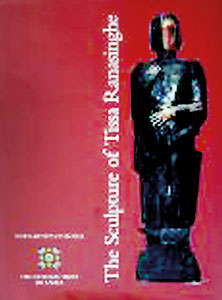Rebirth of an old art through the twists and turns of the artiste
View(s):Book facts: The Sculpture of Tissa Ranasinghe by Neville Weereratne. Reviewed by Rohan de Soysa
Imagine the seed of an ancient tree, presumed extinct, lying dormant in the soil for 800 years, suddenly sprouting and producing a shoot. The shoot grows vigorously, becomes a sturdy tree and then produces seeds of its own. These go on to revitalise and proliferate this almost extinct species.

So it was with the art of making bronze sculpture, a once flourishing art up to the 12th Century, which then became defunct in this land. Tissa Ranasinghe was the seed that sprouted, more by chance than by design in the 20th Century, to become the first of a renewed line of makers of meaningful bronze images. His works, rather more playful than those of 800 years ago, nevertheless concern themselves with the essence of universal timeless truths and emotions, in imagery suitable for the present day.
Such an achievement deserves to be celebrated in a fitting manner. That is exactly what the National Trust sponsored by the G. C. Mendis Memorial Trust Fund has done. The different facets of contributions made by Neville Weereratne, Amahl Weereratne, Professor Albert Dharmasiri, late Michael Wright, Professor Sir Eduardo Paolozzi and Robert Vigneau provide a comprehensive work. The book resembles Tissa’s sculptures; full of varied planes and textures, each contributor revealing something new, making a meaningful whole.
This book, the first in the series “Seven Artists of an Era” planned by the National Trust- Sri Lanka, is more than just a collectors piece. We are able to follow Tissa through the twists and turns, the ups and downs of his life–a life not always easy but single-minded once he found his true calling. We are given a fascinating account of the intricacies of bronze casting and the conversion into finished work. The technicalities are described in simple language perfectly understandable to a layman.
Albert Dharmasiri’s succinct and penetrating preface ably summarizes the inspiration and motivation underlying Tissa’s work. He indicates that Tissa’s skill as a draughtsman played no little part in the making of his sculptures. Neville Weereratne, the doyen of our modern art chroniclers, then gives us a glimpse into the nature of the man that Tissa is, in his introduction.
Then follows the solid main thesis “The Sculpture of Tissa Ranasinghe”. It covers the highlights of Tissa’s career, the numerous exhibitions in which he participated and the many awards he received. It also gives us important insights into the world as seen by sculptors who work in three dimensions as opposed to artists who work in two dimensions. Tissa, who worked in terracotta as well, sometimes on a large scale, could be said to have mastered two and a half dimensions, too. His adornment of the Sri Lanka stall at the Expo 67 exhibition in Montreal is also noteworthy and has been described in detail.
The appendices which follow by the late Michael Wright, Sir Eduardo Paolozzi and Robert Vigneau shed further light on Tissa both as a human being and as a maker of objects. Robert Vigneau’s is particularly touching and often amusing as he had a long and close association with Tissa exploring together among other things many ‘eateries’ both here and abroad – an interest they both had in common. He also had the privilege of being present at the casting of a bronze at the foundry on Tissa’s brother’s coconut estate in Yogiyana – a bronze head of none other than himself!
“The Sculpture of Tissa Ranasinghe” is a well conceived, well designed, well illustrated, eminently readable and enjoyable volume which will surely enrich the libraries of art lovers.
This book is available at the National Trust – Sri Lanka office at the Post Graduate Institute of Archaeology, 407, Bauddhaloka Mawatha, Colombo 7( tel: 2682730) and at the leading bookshops in Colombo .
(The reviewer is Chairman, Sapumal Foundation)
Follow @timesonlinelk
comments powered by Disqus


